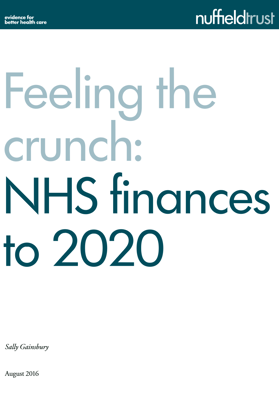Report: NHS Finances to 2020
As recognised by the NHS’s Five Year Forward View, by 2020 the NHS will need to find savings of around £22 billion in order to balance its books. But there has been no clear articulation of how that gap is expected to be closed. The options for doing so include NHS providers becoming more efficient; NHS commissioners reducing the pace at which NHS activity is increasing each year, either through reducing demand or limiting access to care; more funding for the NHS; or some combination of these. This analysis examines different scenarios to determine exactly what it would take to close the gap.
Summary
This briefing lays out how greater speed through a system often requires more space. Looking at trusts that meet the four hour target and those furthest from meeting it, it estimates that at least 5.5% of beds need to be free for the standard to be met. Yet many hospitals are unable to provide this much of the time, making target breaches inevitable.
The paper looks at ongoing changes driving this squeeze on bed space, including mortality, the squeeze on bed space during years of austerity, rising numbers of patients with multiple conditions, and delayed discharges.
An analysis examines how bed use and patient flow change through the course of the day, drawing on Hospital Episode Statistics which track admissions and discharges. It shows that bed occupancy does not peak at midnight, when the official census of patients is carried out, but in mid morning. Meanwhile, the highest need for patients to be moved through hospital peaks at an entirely different time of day, in the evening.
With the NHS facing an unprecedented financial squeeze, the briefing looks at solutions available short of actually building enough beds to restore free space. It suggests managers should focus in particular on the minority of long-staying patients who account for a majority of bed use. Given the variation during the day, and with an increasing number of patients leaving in a matter of hours, it urges the NHS to invest in IT and management systems that can track and deal with the need for beds and patient movement in real time.
These different sections will be of interest to different people – those managing beds, those looking at local health services as a whole, and those thinking about the resources needed by the NHS nationally. The document has a hyperlinked contents page allowing readers to jump straight into different sections.
Source: Nuffield Trust




